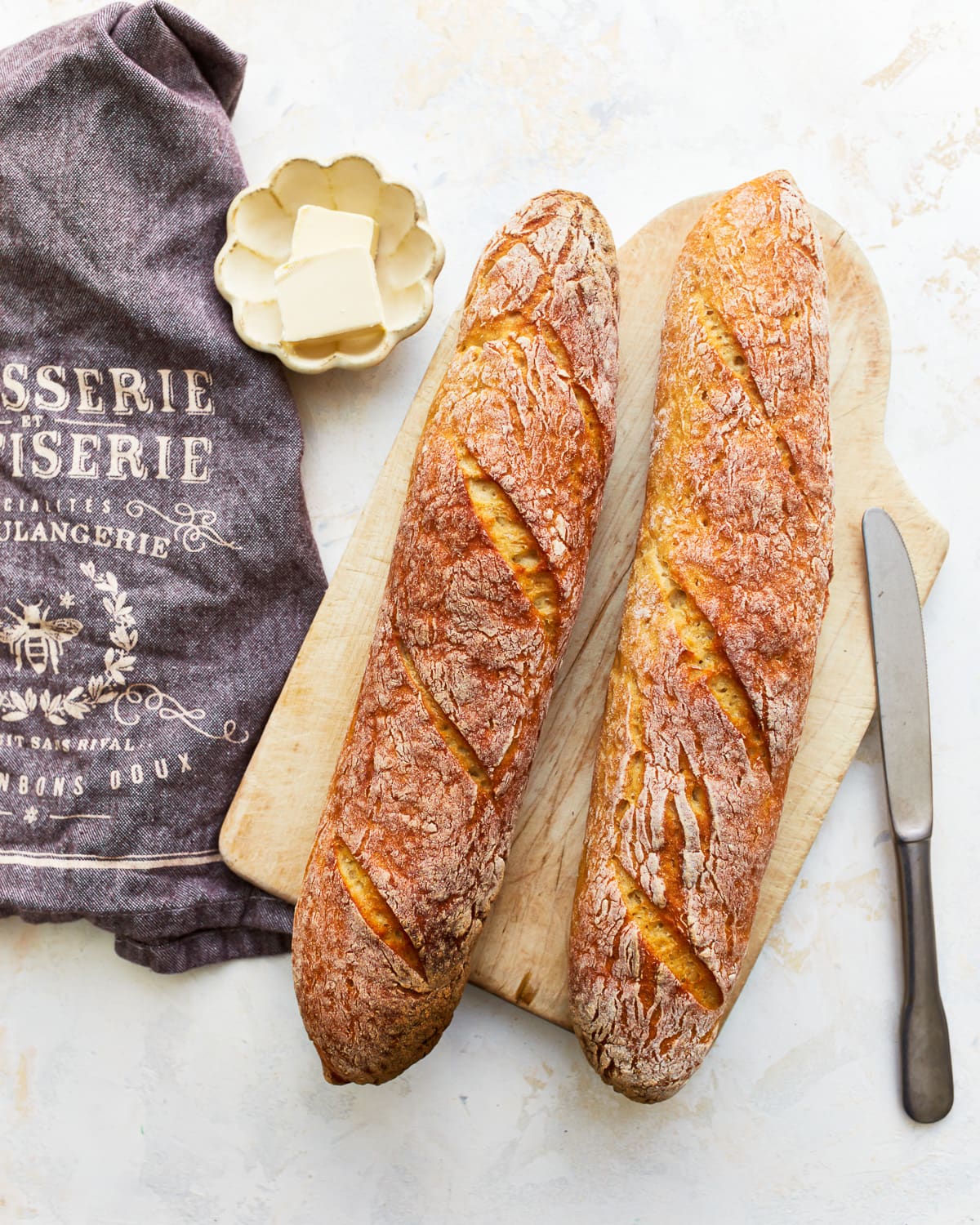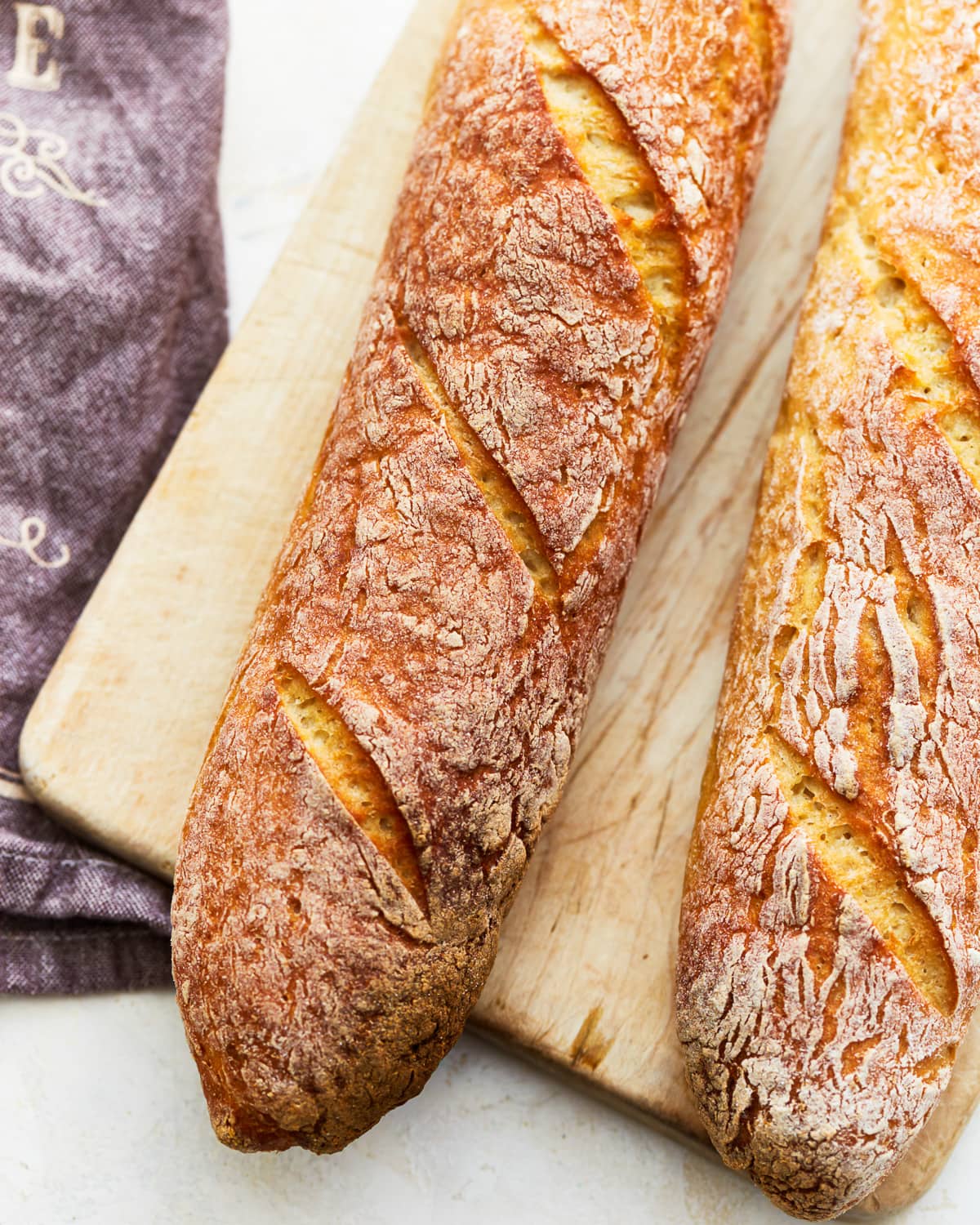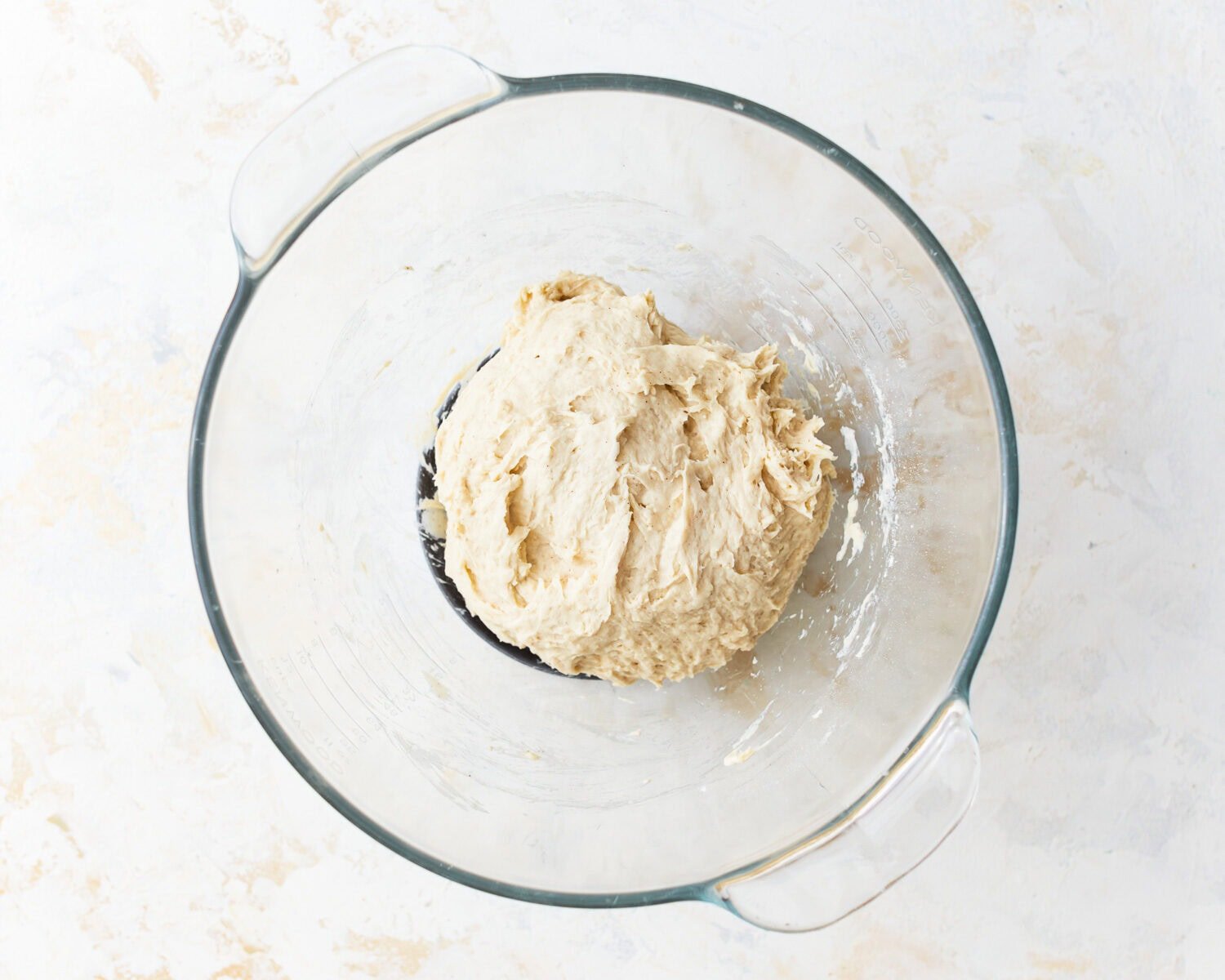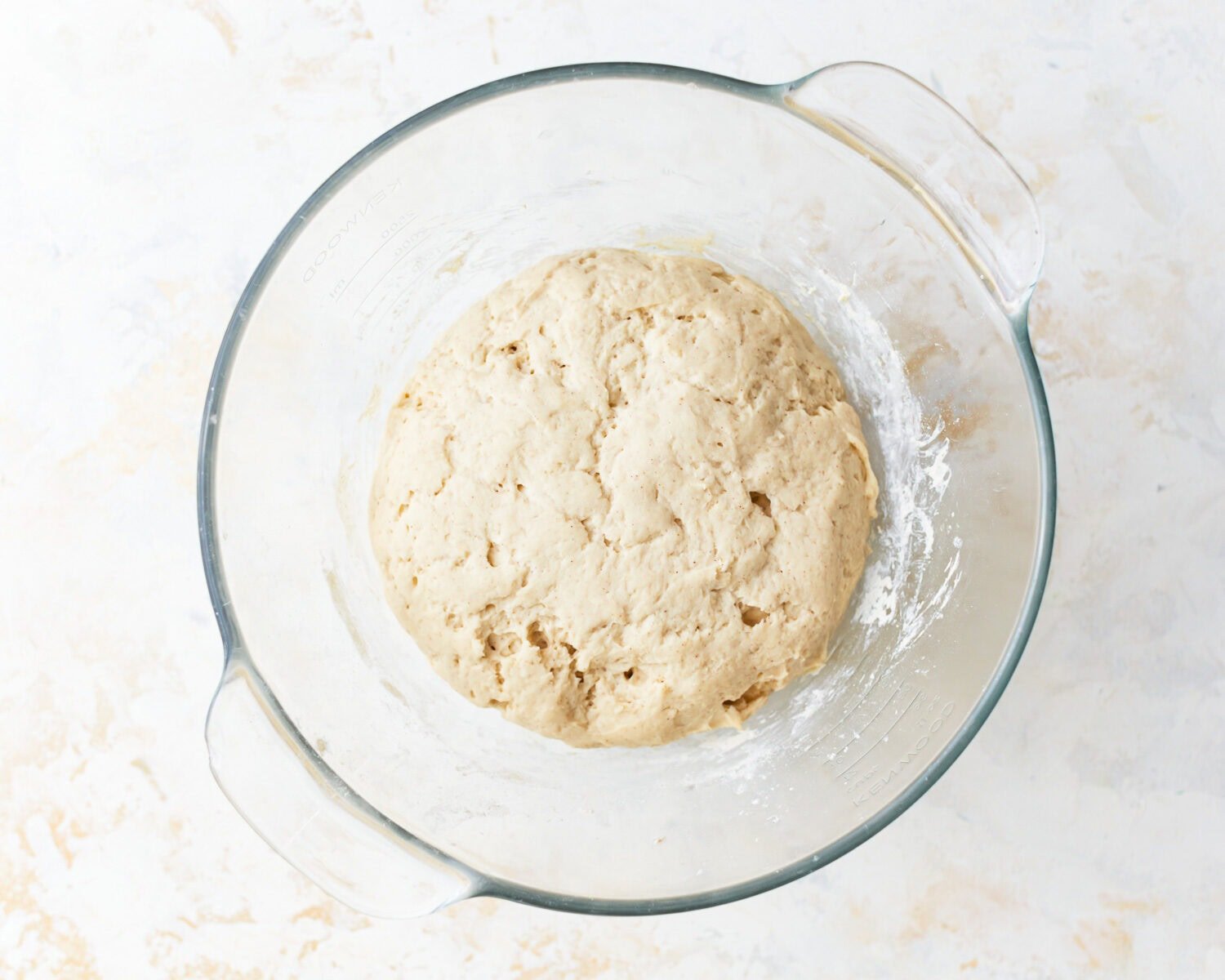Gluten-Free Baguette
Published
Picture this, you’re strolling along the Seine with a coffee in one hand and a freshly baked baguette in the other… Okay, we can’t all go to Paris, but a girl can dream, right?! Well, I’m making this dream a reality with this gluten-free baguette recipe. A soft, tender crumb and a crunchy crust are both possible with this gluten-free French baguette. I love it for snacking or making sandwiches for the family.

Gluten-Free Baguette Recipe
A baguette is a long, thin French bread made from a very simple dough. It’s known for its length and exceptionally crispy crust. I miss breaking a warm baguette in half and slathering it with salted butter, so I knew I had to develop a gluten-free baguette recipe to sate those cravings! And of course, I use dairy-free Smart Balance butter.
Follow my foolproof recipe plus tips and tricks for how to make the perfect gluten-free French baguette.
Ingredients
- Gluten-Free All-Purpose Flour with Xanthan Gum recommended for yeast baking: Not all gluten-free flour blends are recommended for yeast baking. You may experience different baking results depending on the gluten-free flour blend you choose. I recommend Pillsbury or Better Batter.
- Salt: Enhances the flavor of the bread.
- Granulated Sugar: Feeds the yeast so the bread will rise.
- Instant Yeast: Helps the bread rise.
- Water: Water should feel warm to the touch, around 100°F to 110°F, which helps activate the yeast without killing it.

Tips and Suggestions
- This dough is more fragile than its gluten-containing counterparts. I have found that handling it gently maintains the air pockets that contribute to the bread’s rise.
- The technique of slashing the dough with a sharp knife or lame just before baking not only helps with the rise but also gives that artisanal look. I like to practice making decisive, swift cuts a few times before doing it to the actual loaves to create a pattern that will open beautifully in the oven.
- While a baking stone can help create a crispy crust by evenly distributing heat, it’s not strictly necessary. You can achieve good results by baking on a regular baking sheet lined with parchment paper.
Why Is My Dough Too Sticky/Dry?
Gluten-free doughs can be sensitive to moisture content, which can be affected by the brand of flour used, humidity, and measuring methods. If your dough is too sticky, add a little more flour, a tablespoon at a time. If it’s too dry, add water by the teaspoon until you reach the right consistency.

Why Didn’t My Baguette Rise?
Several factors can affect the rise of your baguettes, including expired yeast, incorrect water temperature (too hot or too cold), or not allowing the dough to rise in a warm enough environment. Ensure your yeast is fresh, your water is warm, and your rising environment is around 75°F (24°C).
How Do I Ensure My Baguettes Have a Crispy Crust?
To achieve a crispy crust, use steam in the oven and bake at a high temperature as instructed. Additionally, cooling the baguettes on a wire rack ensures that the bottom crust doesn’t become soggy.
Storage Instructions
I prefer to store cooled baguettes in an airtight container at room temperature for up to 2 days. For longer storage, I usually wrap them tightly in foil and freeze them for up to 1 month. Reheat in a 350°F oven for 5-10 minutes to restore the crust’s crispiness.

There’s truly nothing better than a fresh-from-the-oven gluten-free baguette dipped in olive oil or spread with butter. I’m in heaven just thinking about it!
More Gluten-Free Bread Recipes to Try!
- Gluten-Free Focaccia
- Easy Gluten-Free Bread
- Gluten-Free Bread Machine Bread
- Gluten-Free Naan Bread
- Gluten-Free Dinner Rolls
Gluten-Free Baguette

Ingredients
- 3 1/4 cups Gluten-Free All-Purpose Flour with Xanthan Gum recommended for yeast baking
- 1 1/2 teaspoons salt
- 1 teaspoon granulated sugar
- 1 teaspoon instant yeast
- 2 cups warm water, 100-110°F
Instructions
- In a large mixing bowl, whisk together the gluten-free flour, salt, sugar, and instant yeast until well mixed.
- Gradually add the water to the dry ingredients, stirring continuously. Mix until all the ingredients are well combined and form a sticky dough.
- Knead gently for 2-3 minutes until the dough is slightly elastic. Gluten-free dough won’t become as elastic as wheat dough, but it should be smooth and manageable.
- Cover with plastic wrap and let it rise in a warm, draft-free place for about 1 hour, or until it nearly doubles in size.
- Gently deflate the dough and divide it into two equal parts. On a lightly floured surface, roll and stretch each piece into a 12-inch long baguette shape. Place these on a baking sheet lined with parchment paper, leaving ample space between them.
- Cover the shaped baguettes with a clean kitchen towel and let them rise for another hour, or until they puff up noticeably.
- About 20 minutes before the second rise is complete, preheat your oven to 475°F (245°C). Place a baking stone inside if you have one, or simply use the middle rack.
- Using a sharp knife or lame, make 3-4 diagonal slashes on top of each baguette. This helps the steam escape during baking and encourages the baguettes to expand.
- Mist the oven with water (to create steam) before quickly placing the baguettes inside. Bake for 25 minutes, or until the baguettes are golden brown and have a hollow sound when tapped on the bottom.
- Remove the baguettes from the oven and transfer them to a wire rack to cool completely. This step is crucial for developing the texture and flavor of the crust.
Notes
- Gluten-free dough is more fragile than its gluten-containing counterparts. I have found that handling it gently maintains the air pockets that contribute to the bread’s rise.
- The technique of slashing the dough with a sharp knife or lame just before baking not only helps with the rise but also gives that artisanal look. I like to practice making decisive, swift cuts a few times before doing it to the actual loaves to create a pattern that will open beautifully in the oven.
- While a baking stone can help create a crispy crust by evenly distributing heat, it’s not strictly necessary. You can achieve good results by baking on a regular baking sheet lined with parchment paper.
- To store: Store gluten-free baguettes in an airtight container at room temperature for up to 2 days.
- To freeze: Freeze tightly wrapped in aluminum foil for up to 1 month.
Nutrition
Nutrition information is automatically calculated, so should only be used as an approximation.
How to Make a Gluten-Free Baguette Step-by-Step

In a large mixing bowl, whisk together 3 1/4 cups gluten-free flour, 1 1/2 teaspoons salt, 1 teaspoon sugar, and 1 teaspoon instant yeast until well mixed.

Gradually add 2 cups warm water to the dry ingredients, stirring continuously. Mix until all the ingredients are well combined and form a sticky dough.

Knead gently for 2-3 minutes until the dough is slightly elastic. Gluten-free dough won’t become as elastic as wheat dough, but it should be smooth and manageable.

Cover with plastic wrap and let it rise in a warm, draft-free place for about 1 hour, or until it nearly doubles in size.

Gently deflate the dough and divide it into two equal parts. On a lightly floured surface, roll and stretch each piece into a 12-inch long baguette shape. Place these on a baking sheet lined with parchment paper, leaving ample space between them.

Cover the shaped baguettes with a clean kitchen towel and let them rise for another hour, or until they puff up noticeably.

About 20 minutes before the second rise is complete, preheat your oven to 475°F (245°C). Place a baking stone inside if you have one, or simply use the middle rack.

Using a sharp knife or lame, make 3-4 diagonal slashes on top of each baguette. This helps the steam escape during baking and encourages the baguettes to expand.

Mist the oven with water (to create steam) before quickly placing the baguettes inside. Bake for 25 minutes, or until the baguettes are golden brown and have a hollow sound when tapped on the bottom.
Remove the baguettes from the oven and transfer them to a wire rack to cool completely. This step is crucial for developing the texture and flavor of the crust.











Followed the recipe to a T. I make a lot of sourdough, yeast bread and even gluten free cupcakes, waffles etc. but sadly this was a gloopy goo mess. I couldn’t even force it to work. I used Namaste GF flour but that’s what I use for cinnamon rolls and cupcakes without issue. The color was also off putting. I took a photo but seems I can’t upload.
This baguette recipe is amazing ! Easy to make and delicious results, I used Caputo fioreglut flour and it turned out like “normal “ baguettes, thanks so much for sharing your recipe 🙂
I’m so sad to write this review.
I have made many other recipes on this site and they have worked out perfectly. I followed the recipe, have a oven thermometer, carefully added moisture… and i had all the same problems as most of the over reviews. It did not rise, it was goopy and dense. It was weirdly white on the top and brown on the bottom.
I am an experienced baker, I am so sad this just doesn’t work out.
I have probably made worse bread than this, but I cannot remember it. I used the metric version, because I wanted to get more accurate measurements. this recipe calls for more water than flour, and more salt than sugar. I was concerned by that but willing to try since I saw positive reviews. My concerns were absolutely correct. At first I ended up with pancake batter, and ended up having to almost double the amount of flour to get my dough to resemble the picture. it still wasn’t exactly kneadable, but I had run out of flour at that point.
I used a mix of King Arthur flour and an entire bag of trader joe’s flour blend.
The bread was fine in texture at the end, but ended up strangely salty. I will not be using this recipe again.
Hi Gabi, So sorry it didn’t turn out well for you. This recipe does call for more flour than water, so the conversion may have been off.
This bread came out perfect. Tasty and soft in the middle with a perfect light taste and crusty outer layer. This was my first attempt at baguettes! I have been missing dipping in olive oil since I went gluten free. Fabulous recipe. Thank you Sabine…
I thought I followed the instructions to the letter, but mine came out quite flat, brown on the bottom but snake white on the top. The flavor is basically salted paste.
Very crunchy, good thing I have good teeth 😁
I’ll eat it because I don’t waste food, but I won’t like it😂
I wonder what I dud wrong. No matter which flour I used, I don’t know what would have fixed the color on top.
Hi Peter, we’re not sure what would cause uneven browning on the top other than if your oven temperature is slightly off. You could try getting an oven thermometer to check. If your baguette turned out flat, we suspect your yeast may be dead and recommend starting with fresh yeast.
can make the baguette shape and put in refrigerator for 8 hours and bake next morning
Hi Victor, yes, but you’ll want to let it come to room temperature and complete the second proof before baking.
can Make the baguette shape an put in the refrigerator for 8 hours and bake next morning.
Would you recommend a baguette pan if I have one? Also, if I have a stone, do I put the baguette loaves directly on the baking stone? Thanks!
Hi Tamara, a baguette pan is great if you have one. We placed our loaves on a baking sheet on the middle rack with the baking stone on the bottom rack.
Can you mix together with a kitchen aid mixmaster with a dough hook or must it be done by hand?
Hi Larry, you can certainly knead in a mixer if you prefer.
Good textured, I followed the instructions exactly and I’m a pretty good baker and have experience with gluten free flour. My loafs didn’t brown up on the tops only the bottoms. Other than that they were ok. I would try this next time with the flour substitute the baker used for this recipe, might get better results.
Sorry – it should have read “feast of bread and butter”. I wish I could have uploaded a picture!
Delicious! We were all pleasantly surprised by how well these loaves came out. It smelled delicious and what started as tasting “samples” became a feat of bread and butter! Nicely browned all over with a shallow pan of water left in the oven.
my loaves only browned on the bottom, not at all on top. I think I may have been too hesitant about how much to knead them. I didn’t knead them too much after the second rise, so they weren’t smooth -topped like yours! oh well, I’ll try again.
Hi Lisa, we recommend making sure your oven is at the correct temperature to ensure a crispy browned crust. It’s also really important to get that steam in the oven, so don’t skip misting the oven!
I did the misting, etc. My loaves didn’t rise well, either. I used brand new bread machine yeast, too! I’m sure it was the baker’s errors… I’ll try again! Thank you for answering my comment 😊
Volume based measurements are simply not adequate for GF baking recipes.
3.5 cups of GF Modernist Bread flour blend was like pancake batter after only adding 1.5 cups of water.
the Modernist Bread GF recipes are excellent but they do not have a baguette hence tried this one–your photos looked amazing.
Hi M, we tested this recipe with Pillsbury GF flour, so your results may vary with a different brand. Furthermore, there is an option right on the recipe card to click “metric” and get gram measurements for a more accurate recipe!